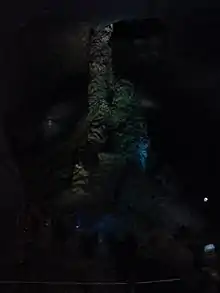Manjanggul
The Manjanggul Lava Tube is located in Gimnyeong-ri, Gujwaeup, Jeju City. At up to 23m wide, 30m high and 8.928km long, it is the 12th-longest lava tube in the world[1] and the second longest on Jeju island.[2] It is regarded as having significant scientific and heritage value, owing to its excellent condition of preservation despite its age of formation (about 300,000 to 200,000 years ago).

| Manjanggul | |
| Hangul | 만장굴 |
|---|---|
| Hanja | |
| Revised Romanization | Manjanggul |
| McCune–Reischauer | Manjanggul |
.jpg.webp)
Lava stalactites and lava stalagmites, lava columns, lava flowstone, lava helictites, lava blisters, cave coral, benches, lava rafts, lava bridges, lava shelves, grooved lava striations, and ropy lava are well-preserved. Among them, a lava column of 7.6 m is the largest known in the world. There are three entrances and No. 2 heading southward is open to the public.
Entrance No. 3 contains the most favorable habitats for cave life and between Entrances 1 and 2, there is a lower level main tube where most of the living creatures can be found. In the Geomunoreum Lava Tube System, the Manjanggul Lava Tube has the greatest number of living creatures, including the Jeju cave-spider. In the upper part of Entrance 2, there are at least 30,000 common bent-wing bats forming the largest colony of bats confirmed to be living in Korea so far.
See also
References
- http://www.caverbob.com/lava.htm
- "Manjang Cave". Wondermondo.
- "World Heritage sites (South Korea)". Korea Herald. 2010-03-30.
- "Jeju volcanic island and lava tubes: Invaluable ecological treasure trove". Korea Herald. 2008-09-12.
- "Jeju sites named UNESCO global geoparks". Korea Herald. 2010-10-04.
- Jeju Special Self-Governing Provincial Tourism Association